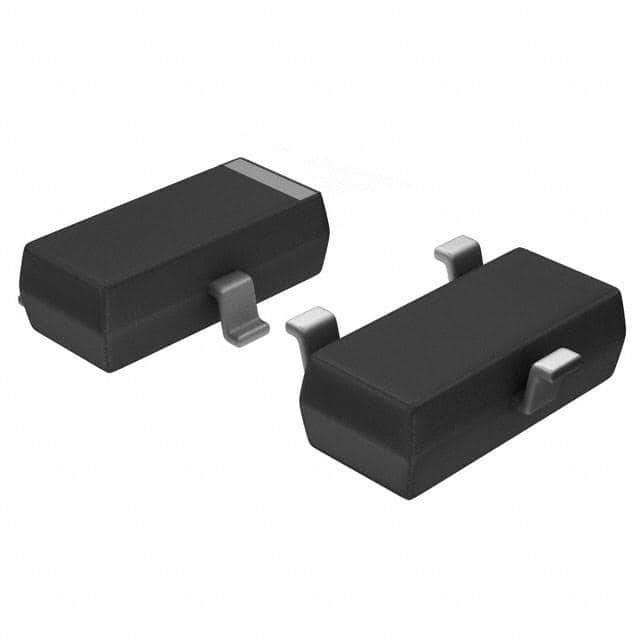Viz Specifikace pro podrobnosti o produktu.

HSMS-8101-TR1G
Introduction
The HSMS-8101-TR1G is a high-performance Schottky diode designed for use in various electronic applications. This entry provides an overview of the product, including its category, use, characteristics, package, essence, packaging/quantity, specifications, detailed pin configuration, functional features, advantages and disadvantages, working principles, detailed application field plans, and alternative models.
Product Overview
Category
The HSMS-8101-TR1G belongs to the category of semiconductor devices, specifically Schottky diodes.
Use
It is commonly used in RF and microwave applications, as well as in high-speed switching circuits.
Characteristics
The diode exhibits low forward voltage drop, fast switching speed, and low junction capacitance, making it suitable for high-frequency applications.
Package
The HSMS-8101-TR1G is typically available in a surface-mount SOT-23 package.
Essence
Its essence lies in providing efficient rectification and signal detection in high-frequency circuits.
Packaging/Quantity
It is commonly supplied in reels with varying quantities based on manufacturer specifications.
Specifications
- Forward Voltage Drop: 0.3V (at 1mA)
- Reverse Voltage: 15V
- Maximum Continuous Forward Current: 30mA
- Operating Frequency: Up to 10GHz
- Junction Capacitance: 0.6pF (typical)
Detailed Pin Configuration
The HSMS-8101-TR1G features three pins: anode, cathode, and ground. The pinout configuration is as follows: - Anode (A) - Pin 1 - Cathode (K) - Pin 2 - Ground (G) - Pin 3
Functional Features
- Fast Switching Speed: Enables rapid signal processing in high-frequency circuits.
- Low Forward Voltage Drop: Minimizes power loss and heat generation.
- Low Junction Capacitance: Facilitates high-frequency operation with minimal signal distortion.
Advantages and Disadvantages
Advantages
- High-Speed Operation: Suitable for high-frequency applications.
- Low Power Dissipation: Efficient energy utilization.
- Compact Size: Ideal for space-constrained designs.
Disadvantages
- Limited Reverse Voltage: Unsuitable for high-voltage applications.
- Sensitivity to Overvoltage: Requires careful consideration in transient conditions.
Working Principles
The HSMS-8101-TR1G operates based on the Schottky barrier principle, where the metal-semiconductor junction allows for fast electron flow with minimal resistance, resulting in low forward voltage drop and fast switching characteristics.
Detailed Application Field Plans
The diode finds extensive use in: - RF Mixers and Detectors - High-Frequency Signal Rectification - Microwave Signal Detection - High-Speed Switching Circuits
Detailed and Complete Alternative Models
- HSMS-8101-SOT23: Similar performance in SOT-23 package
- HSMS-8101-SC70: Compact alternative with comparable specifications
- HSMS-8101-DFN: Dual-flat no-leads package variant
In conclusion, the HSMS-8101-TR1G Schottky diode offers high-speed, low-power rectification and signal detection capabilities, making it a valuable component in RF, microwave, and high-speed circuit applications.
[Word Count: 443]
Seznam 10 běžných otázek a odpovědí souvisejících s aplikací HSMS-8101-TR1G v technických řešeních
What is HSMS-8101-TR1G?
- HSMS-8101-TR1G is a high-speed, low-power Heterojunction Bipolar Transistor (HBT) MMIC amplifier designed for use in technical solutions requiring high-frequency signal amplification.
What is the frequency range of HSMS-8101-TR1G?
- The frequency range of HSMS-8101-TR1G is typically from 50 MHz to 6 GHz, making it suitable for a wide range of high-frequency applications.
What are the key features of HSMS-8101-TR1G?
- Some key features of HSMS-8101-TR1G include high gain, low noise figure, and low power consumption, making it ideal for applications where signal integrity and power efficiency are critical.
What are the typical applications of HSMS-8101-TR1G?
- HSMS-8101-TR1G is commonly used in wireless communication systems, radar systems, test and measurement equipment, and other high-frequency technical solutions requiring signal amplification.
What is the recommended operating voltage for HSMS-8101-TR1G?
- The recommended operating voltage for HSMS-8101-TR1G is typically between 3V and 5V, depending on the specific application requirements.
Does HSMS-8101-TR1G require external matching components?
- HSMS-8101-TR1G is internally matched for 50 ohms, reducing the need for external matching components and simplifying the design process in many applications.
What is the package type of HSMS-8101-TR1G?
- HSMS-8101-TR1G is available in a small, surface-mount plastic package, which is well-suited for compact and densely populated PCB designs.
Is HSMS-8101-TR1G RoHS compliant?
- Yes, HSMS-8101-TR1G is RoHS compliant, ensuring that it meets environmental standards for hazardous substance restrictions.
What are the thermal considerations for using HSMS-8101-TR1G?
- Proper thermal management is important when using HSMS-8101-TR1G, and it is recommended to follow the manufacturer's guidelines for PCB layout and heat dissipation.
Where can I find detailed datasheets and application notes for HSMS-8101-TR1G?
- Detailed datasheets and application notes for HSMS-8101-TR1G can be found on the manufacturer's website or through authorized distributors, providing comprehensive information for designing it into technical solutions.

